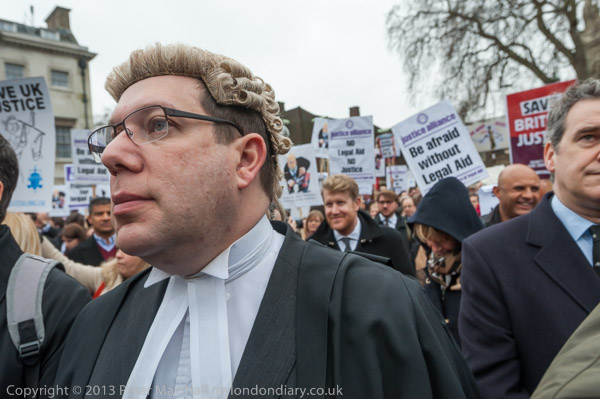
It was perhaps appropriately a rather grey day when lawyers came to Old Palace Yard opposite Parliament to show their outrage at the response by Justice Minister Chris Grayling to his Transforming Legal Aid consultation on criminal legal aid. They describe it as ‘A shameful day in legal history’ and it was hard to pick a fault in their case, though it was perhaps naive to expect anything positive to emerge from any ‘consultation’. Governments have never been strong on consultation, and for present ministers they are certainly just an opportunity for people to talk to deaf ears before they do exactly what they had previously decided.
They are almost completely discredited exercises by a government that prefers its own dogmatic and largely unthinking solutions. The only kind of logic behind its proposals appears to be that people who get brought to court are criminals and we shouldn’t waste much public money giving them a proper defence.
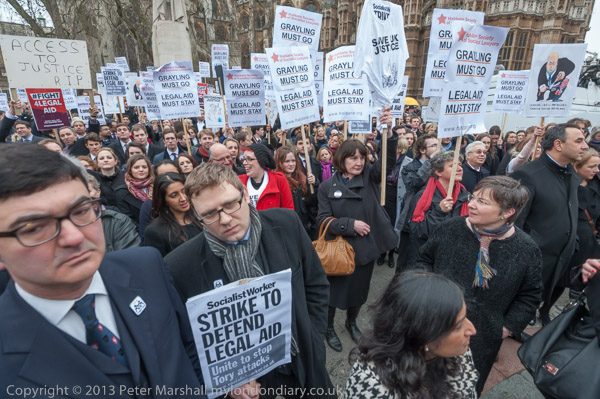
Lawyers as a whole are generally rather unexciting visually, and looking at the crowd as a whole it seemed a dark mass. There was something a little surreal seeing barristers and solicitors many in legal dress of black gown and horsehair wig holding up placards and shouting slogans in a political protest on what was their first every full day’s strike.
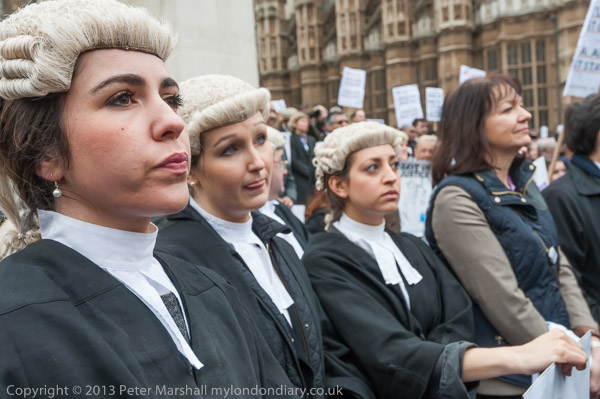
Legal dress is worn far less now in courts, and for some of those attending it was a fairly rare outing for their ridiculously expensive horse-hair.
Our legal system is ridiculously expensive, and in need of extensive reform to make better use of the time of everyone concerned. There are occasional abuses of legal aid, with some taking advantage of it who should not be and others who need it not being eligible. But while some reforms are needed, the government proposals seem simply to be about saving money at the expense of those on trial, making them far less likely to get justice.
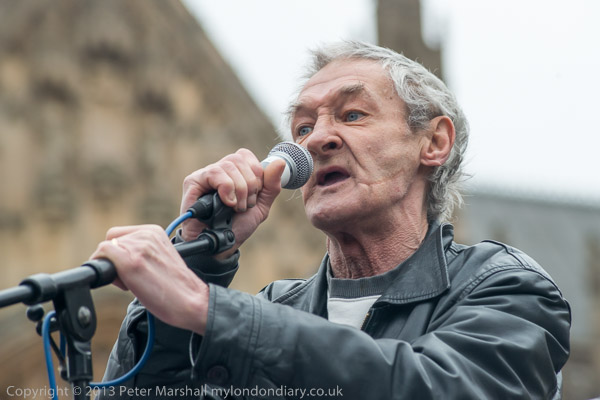
Certainly the most impressive and powerful speech at the event came from a man who had been wrongfully convicted for an offence he did not convict. Better legal aid at his initial trail might have made the initial miscarriage of justice and the life sentence less likely, but it was legal aid that enabled Paddy Hill and the others of the Birmingham Six to eventually get justice. Had Grayling’s proposal already been in force they would still be in jail for a bombing they did not commit.
It was an electric and rabble-rousing call for revolution, if in the situation only theatrical. By contrast most of the other speeches seemed a little dull and pedestrian. Hill too was more interesting to photograph, with a strong face and a full range of expressions, while some of the lawyers were about as interesting as a blancmange. There were exceptions – including most if not all of the women who spoke, but by the end of the speeches (I think around two hours of them) I’d had enough.
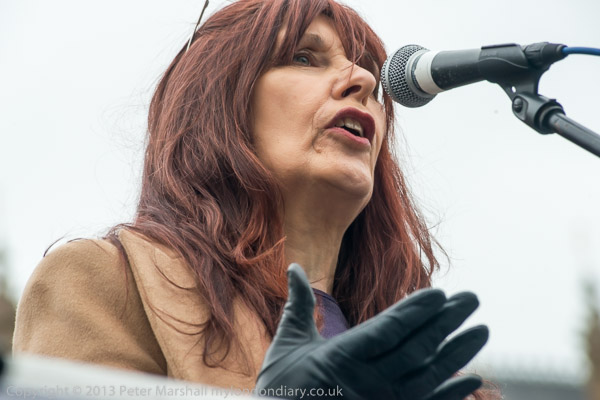
The speakers were on a scaffolding platform, standing with their feet around head height with the main event banner in front of them. Some stood a little back and were too much obscured by the banner. Mostly for the speakers I was using the 70-300mm Nikon on the D800E. It’s a full-frame lens and I didn’t think to set the camera to use it in DX mode, so they are 32Mb files, much larger than I need. At ISO800 most a typical exposure was 1/400 f10, and I was working at focal lengths from around 100 to 300mm. The lens isn’t at its best above around 200mm and it would probably have been better to use it in DX mode for these tighter views.
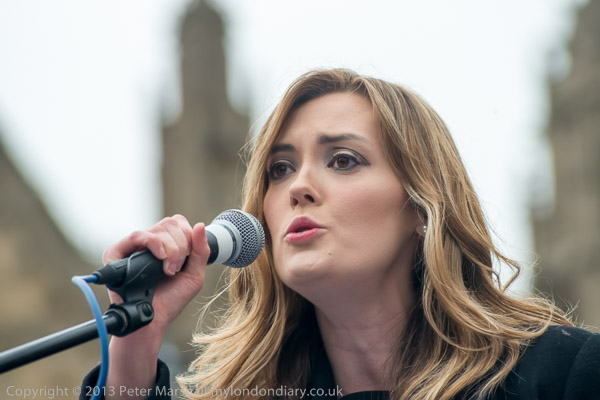
A big problem when photographing speakers at events is the microphone. Different speakers use them in different ways, some staying very close, others standing back more – almost always better for the photographer.
At many events there is a crowd of photographers that make it hard to change position, particularly when celebrities are speaking. Here there were no real celebrities, and there was quite a lot of relatively empty space in front of the platform so I was able to move around and pick my angles. I live to work from one or other side, at least so the speaker’s mouth is not obscured (though that’s hard with the mike-huggers.) Here I was able to move closer or further away, with one of two images from quite a close position looking up as well as those with a long lens from a distance.
Changing position also varies the background, with some pictures against almost entirely empty sky, and others with parts of the Houses of Parliament visible – with different degrees of blur.
The came the march to the Ministry of Justice, via the Liberal Party HQ, where Paddy Hill led those going into the offices with their letters – and I’d taken up position to photograph him doing so, and a minute or so later photographed him inside after letting some of the others follow him.
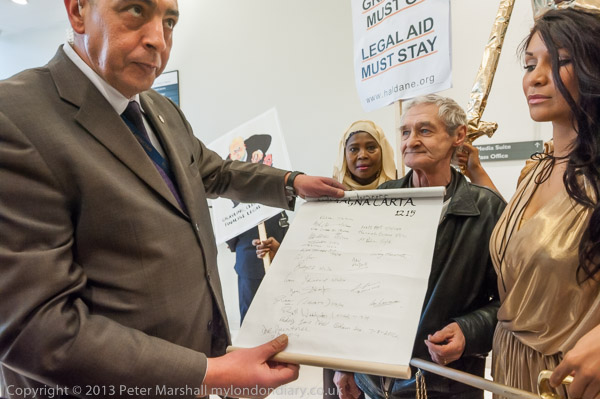
When a small group went inside the Ministry of Justice led again by Hill carrying a scroll to present for the minister I was with them, and walked past the rather surprised-looking security guards to photograph the scroll being presented to an official. When I saw him rolling it after looking at it with its back towards me, I asked him if he could show it to us too, and he did. I think it made a better picture. I don’t really think it counts as setting it up.
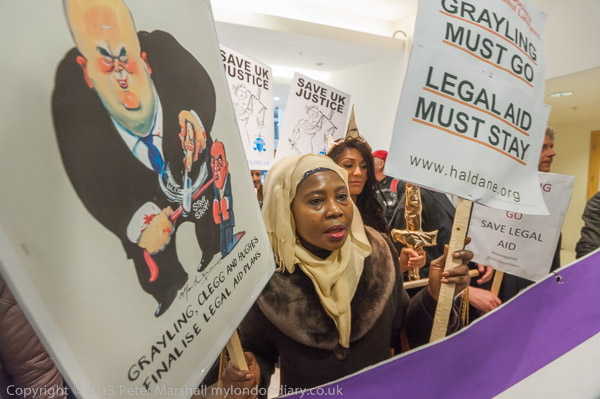
As we turned away to leave the ministry, more protesters and photographers pushed in, and things got a little more interesting, though everyone eventually left after the security had requested us to do so.
Story and pictures: Outraged Lawyers Legal Aid Protest
______________________________________________________
My London Diary : Buildings of London : River Lea/Lee Valley : London’s Industrial Heritage
All photographs on this and my other sites, unless otherwise stated, are taken by and copyright of Peter Marshall, and are available for reproduction or can be bought as prints.
To order prints or reproduce images
________________________________________________________